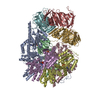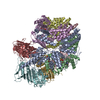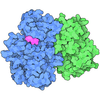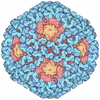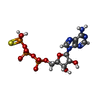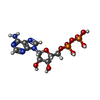+ データを開く
データを開く
- 基本情報
基本情報
| 登録情報 |  | ||||||||||||
|---|---|---|---|---|---|---|---|---|---|---|---|---|---|
| タイトル | Cryo-EM map of human clmap-clamp loader ATAD5-RFC-gapped PCNA complex in intermediate state 3 | ||||||||||||
 マップデータ マップデータ | Final sharpen cryo-EM map | ||||||||||||
 試料 試料 |
| ||||||||||||
 キーワード キーワード | AAA ATPase / Clamp unloader / MOTOR PROTEIN | ||||||||||||
| 機能・相同性 |  機能・相同性情報 機能・相同性情報DNA clamp unloader activity / positive regulation of cell cycle G2/M phase transition / Elg1 RFC-like complex / DNA replication factor C complex / Ctf18 RFC-like complex / nuclear DNA replication / positive regulation of deoxyribonuclease activity / dinucleotide insertion or deletion binding / PCNA-p21 complex / mitotic telomere maintenance via semi-conservative replication ...DNA clamp unloader activity / positive regulation of cell cycle G2/M phase transition / Elg1 RFC-like complex / DNA replication factor C complex / Ctf18 RFC-like complex / nuclear DNA replication / positive regulation of deoxyribonuclease activity / dinucleotide insertion or deletion binding / PCNA-p21 complex / mitotic telomere maintenance via semi-conservative replication / positive regulation of isotype switching to IgG isotypes / DNA clamp loader activity / purine-specific mismatch base pair DNA N-glycosylase activity / nuclear lamina / positive regulation of DNA-directed DNA polymerase activity / Polymerase switching / MutLalpha complex binding / Telomere C-strand (Lagging Strand) Synthesis / Processive synthesis on the lagging strand / PCNA complex / Removal of the Flap Intermediate / isotype switching / Processive synthesis on the C-strand of the telomere / Polymerase switching on the C-strand of the telomere / Mismatch repair (MMR) directed by MSH2:MSH3 (MutSbeta) / Mismatch repair (MMR) directed by MSH2:MSH6 (MutSalpha) / Removal of the Flap Intermediate from the C-strand / Transcription of E2F targets under negative control by DREAM complex / replisome / response to L-glutamate / regulation of mitotic cell cycle phase transition / HDR through Single Strand Annealing (SSA) / negative regulation of intrinsic apoptotic signaling pathway in response to DNA damage by p53 class mediator / Impaired BRCA2 binding to RAD51 / DNA strand elongation involved in DNA replication / response to dexamethasone / DNA synthesis involved in DNA repair / histone acetyltransferase binding / DNA polymerase processivity factor activity / leading strand elongation / G1/S-Specific Transcription / replication fork processing / nuclear replication fork / Presynaptic phase of homologous DNA pairing and strand exchange / SUMOylation of DNA replication proteins / signal transduction in response to DNA damage / PCNA-Dependent Long Patch Base Excision Repair / intrinsic apoptotic signaling pathway in response to DNA damage by p53 class mediator / ATP-dependent activity, acting on DNA / response to cadmium ion / translesion synthesis / mismatch repair / estrous cycle / Activation of ATR in response to replication stress / cyclin-dependent protein kinase holoenzyme complex / Translesion synthesis by REV1 / Translesion synthesis by POLK / base-excision repair, gap-filling / DNA polymerase binding / Translesion synthesis by POLI / Gap-filling DNA repair synthesis and ligation in GG-NER / positive regulation of B cell proliferation / epithelial cell differentiation / liver regeneration / positive regulation of DNA repair / TP53 Regulates Transcription of Genes Involved in G2 Cell Cycle Arrest / Termination of translesion DNA synthesis / positive regulation of DNA replication / replication fork / Recognition of DNA damage by PCNA-containing replication complex / nuclear estrogen receptor binding / Translesion Synthesis by POLH / male germ cell nucleus / HDR through Homologous Recombination (HRR) / Dual Incision in GG-NER / G2/M DNA damage checkpoint / receptor tyrosine kinase binding / Dual incision in TC-NER / Gap-filling DNA repair synthesis and ligation in TC-NER / DNA-templated DNA replication / cellular response to hydrogen peroxide / cellular response to xenobiotic stimulus / cellular response to UV / E3 ubiquitin ligases ubiquitinate target proteins / response to estradiol / Processing of DNA double-strand break ends / heart development / chromatin organization / Regulation of TP53 Activity through Phosphorylation / damaged DNA binding / chromosome, telomeric region / DNA replication / cell population proliferation / nuclear body / DNA repair / centrosome / chromatin binding / chromatin / protein-containing complex binding / enzyme binding 類似検索 - 分子機能 | ||||||||||||
| 生物種 |  Homo sapiens (ヒト) Homo sapiens (ヒト) | ||||||||||||
| 手法 | 単粒子再構成法 / クライオ電子顕微鏡法 / 解像度: 4.2 Å | ||||||||||||
 データ登録者 データ登録者 | Wang F / He Q / Li H | ||||||||||||
| 資金援助 |  米国, 3件 米国, 3件
| ||||||||||||
 引用 引用 |  ジャーナル: Nat Struct Mol Biol / 年: 2024 ジャーナル: Nat Struct Mol Biol / 年: 2024タイトル: The human ATAD5 has evolved unique structural elements to function exclusively as a PCNA unloader. 著者: Feng Wang / Qing He / Nina Y Yao / Michael E O'Donnell / Huilin Li /  要旨: Humans have three different proliferating cell nuclear antigen (PCNA) clamp-loading complexes: RFC and CTF18-RFC load PCNA onto DNA, but ATAD5-RFC can only unload PCNA from DNA. The underlying ...Humans have three different proliferating cell nuclear antigen (PCNA) clamp-loading complexes: RFC and CTF18-RFC load PCNA onto DNA, but ATAD5-RFC can only unload PCNA from DNA. The underlying structural basis of ATAD5-RFC unloading is unknown. We show here that ATAD5 has two unique locking loops that appear to tie the complex into a rigid structure, and together with a domain that plugs the DNA-binding chamber, prevent conformation changes required for DNA binding, likely explaining why ATAD5-RFC is exclusively a PCNA unloader. These features are conserved in the yeast PCNA unloader Elg1-RFC. We observe intermediates in which PCNA bound to ATAD5-RFC exists as a closed planar ring, a cracked spiral or a gapped spiral. Surprisingly, ATAD5-RFC can open a PCNA gap between PCNA protomers 2 and 3, different from the PCNA protomers 1 and 3 gap observed in all previously characterized clamp loaders. | ||||||||||||
| 履歴 |
|
- 構造の表示
構造の表示
- ダウンロードとリンク
ダウンロードとリンク
-EMDBアーカイブ
| マップデータ |  emd_42287.map.gz emd_42287.map.gz | 117.8 MB |  EMDBマップデータ形式 EMDBマップデータ形式 | |
|---|---|---|---|---|
| ヘッダ (付随情報) |  emd-42287-v30.xml emd-42287-v30.xml emd-42287.xml emd-42287.xml | 26.7 KB 26.7 KB | 表示 表示 |  EMDBヘッダ EMDBヘッダ |
| FSC (解像度算出) |  emd_42287_fsc.xml emd_42287_fsc.xml | 10.6 KB | 表示 |  FSCデータファイル FSCデータファイル |
| 画像 |  emd_42287.png emd_42287.png | 61.2 KB | ||
| Filedesc metadata |  emd-42287.cif.gz emd-42287.cif.gz | 7.7 KB | ||
| その他 |  emd_42287_additional_1.map.gz emd_42287_additional_1.map.gz emd_42287_additional_2.map.gz emd_42287_additional_2.map.gz emd_42287_half_map_1.map.gz emd_42287_half_map_1.map.gz emd_42287_half_map_2.map.gz emd_42287_half_map_2.map.gz | 111 MB 61.2 MB 116.1 MB 116.1 MB | ||
| アーカイブディレクトリ |  http://ftp.pdbj.org/pub/emdb/structures/EMD-42287 http://ftp.pdbj.org/pub/emdb/structures/EMD-42287 ftp://ftp.pdbj.org/pub/emdb/structures/EMD-42287 ftp://ftp.pdbj.org/pub/emdb/structures/EMD-42287 | HTTPS FTP |
-検証レポート
| 文書・要旨 |  emd_42287_validation.pdf.gz emd_42287_validation.pdf.gz | 904.9 KB | 表示 |  EMDB検証レポート EMDB検証レポート |
|---|---|---|---|---|
| 文書・詳細版 |  emd_42287_full_validation.pdf.gz emd_42287_full_validation.pdf.gz | 904.5 KB | 表示 | |
| XML形式データ |  emd_42287_validation.xml.gz emd_42287_validation.xml.gz | 19 KB | 表示 | |
| CIF形式データ |  emd_42287_validation.cif.gz emd_42287_validation.cif.gz | 24.7 KB | 表示 | |
| アーカイブディレクトリ |  https://ftp.pdbj.org/pub/emdb/validation_reports/EMD-42287 https://ftp.pdbj.org/pub/emdb/validation_reports/EMD-42287 ftp://ftp.pdbj.org/pub/emdb/validation_reports/EMD-42287 ftp://ftp.pdbj.org/pub/emdb/validation_reports/EMD-42287 | HTTPS FTP |
-関連構造データ
- リンク
リンク
| EMDBのページ |  EMDB (EBI/PDBe) / EMDB (EBI/PDBe) /  EMDataResource EMDataResource |
|---|---|
| 「今月の分子」の関連する項目 |
- マップ
マップ
| ファイル |  ダウンロード / ファイル: emd_42287.map.gz / 形式: CCP4 / 大きさ: 125 MB / タイプ: IMAGE STORED AS FLOATING POINT NUMBER (4 BYTES) ダウンロード / ファイル: emd_42287.map.gz / 形式: CCP4 / 大きさ: 125 MB / タイプ: IMAGE STORED AS FLOATING POINT NUMBER (4 BYTES) | ||||||||||||||||||||
|---|---|---|---|---|---|---|---|---|---|---|---|---|---|---|---|---|---|---|---|---|---|
| 注釈 | Final sharpen cryo-EM map | ||||||||||||||||||||
| ボクセルのサイズ | X=Y=Z: 0.828 Å | ||||||||||||||||||||
| 密度 |
| ||||||||||||||||||||
| 対称性 | 空間群: 1 | ||||||||||||||||||||
| 詳細 | EMDB XML:
|
-添付データ
- 試料の構成要素
試料の構成要素
+全体 : ATAD5-RFC-gapped PCNA
+超分子 #1: ATAD5-RFC-gapped PCNA
+分子 #1: ATPase family AAA domain-containing protein 5
+分子 #2: Replication factor C subunit 2
+分子 #3: Replication factor C subunit 5
+分子 #4: Replication factor C subunit 4
+分子 #5: Replication factor C subunit 3
+分子 #6: Proliferating cell nuclear antigen
+分子 #7: MAGNESIUM ION
+分子 #8: PHOSPHOTHIOPHOSPHORIC ACID-ADENYLATE ESTER
+分子 #9: ADENOSINE-5'-DIPHOSPHATE
-実験情報
-構造解析
| 手法 | クライオ電子顕微鏡法 |
|---|---|
 解析 解析 | 単粒子再構成法 |
| 試料の集合状態 | particle |
- 試料調製
試料調製
| 濃度 | 1.0 mg/mL |
|---|---|
| 緩衝液 | pH: 7.5 |
| 凍結 | 凍結剤: ETHANE |
- 電子顕微鏡法
電子顕微鏡法
| 顕微鏡 | FEI TITAN |
|---|---|
| 撮影 | フィルム・検出器のモデル: GATAN K3 (6k x 4k) / 平均電子線量: 60.0 e/Å2 |
| 電子線 | 加速電圧: 300 kV / 電子線源:  FIELD EMISSION GUN FIELD EMISSION GUN |
| 電子光学系 | 照射モード: FLOOD BEAM / 撮影モード: DIFFRACTION / 最大 デフォーカス(公称値): 2.0 µm / 最小 デフォーカス(公称値): 1.0 µm |
- 画像解析
画像解析
| 初期モデル | モデルのタイプ: NONE |
|---|---|
| 最終 再構成 | 解像度のタイプ: BY AUTHOR / 解像度: 4.2 Å / 解像度の算出法: FSC 0.143 CUT-OFF / 使用した粒子像数: 55855 |
| 初期 角度割当 | タイプ: RANDOM ASSIGNMENT |
| 最終 角度割当 | タイプ: RANDOM ASSIGNMENT |
 ムービー
ムービー コントローラー
コントローラー



